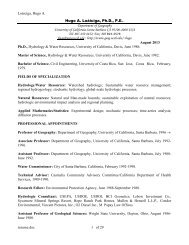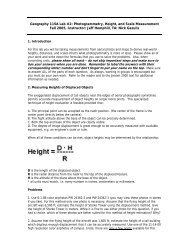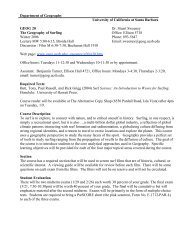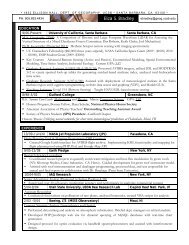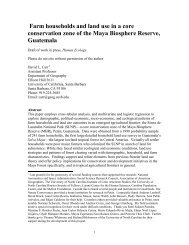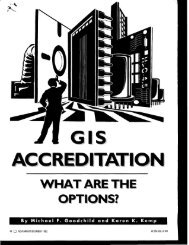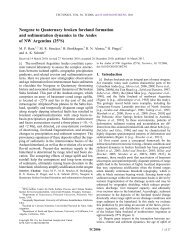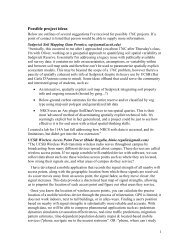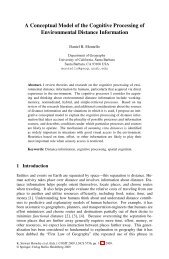126 T. Ishikawa, D.R. Montello / Cognitive Psychology 52 (2006) 93–129 make navigational decisions, such as Wnd<strong>in</strong>g a new route <strong>in</strong> <strong>the</strong> study area. Of course, participants could be given monetary rewards for correct performance. A Wnal issue concerns <strong>the</strong> mode by which one <strong>experience</strong>s <strong>the</strong> environment. In our experiment, participants were driven <strong>in</strong> a car. The diVerences between active and passive learn<strong>in</strong>g, and between walk<strong>in</strong>g and driv<strong>in</strong>g, deserve fur<strong>the</strong>r research. Waller, Loomis, and Steck (2003) and Waller, Loomis, and Haun (2004) found that vestibular sens<strong>in</strong>g of accelerations <strong>in</strong> a car (<strong>in</strong>ertial <strong>in</strong>formation) contributed m<strong>in</strong>imally to spatial learn<strong>in</strong>g <strong>in</strong> large-scale environments, but that <strong>the</strong> additional proprioceptive <strong>in</strong>formation provided by walk<strong>in</strong>g (such as k<strong>in</strong>es<strong>the</strong>sis and eVerence copy) did facilitate environmental learn<strong>in</strong>g. 6. Conclusion In conclusion, we believe that models of spatial learn<strong>in</strong>g, <strong>in</strong>clud<strong>in</strong>g explicit computational models (e.g., Chown, Kaplan, & Kortenkamp, 1995; Kuipers, 2000; Yeap & JeVeries, 1999), must be able to account for people who perform at high levels, sometimes astonish<strong>in</strong>gly high levels, not just people who are average or even poor. In that respect, <strong>the</strong> most important implication of our research may be that some people can and do acquire surpris<strong>in</strong>gly accurate metric <strong>knowledge</strong>, even relatively quickly, <strong>in</strong>clud<strong>in</strong>g relational <strong>knowledge</strong> about places between which <strong>the</strong>y have not <strong>direct</strong>ly traveled. Appendix A These sample sketch maps (Fig. 13) were drawn by four diVerent participants <strong>in</strong> <strong>the</strong> last session; <strong>the</strong>ir respective bidimensional correlations are shown. They exemplify how <strong>the</strong> degree of correspondence between sketch maps and <strong>the</strong> actual layout changes as <strong>the</strong> bidimensional regression becomes smaller. The remarkable accuracy of participant P1’s sketch map (r D .95) is evident when it is compared to <strong>the</strong> actual map of <strong>the</strong> study area <strong>in</strong> Fig. 2. At <strong>the</strong> same time, it should be noted that all <strong>the</strong> maps accurately show qualitative properties of <strong>the</strong> routes such as <strong>the</strong> names and sequences of landmarks. References Aguirre, G. K., & D’Esposito, M. (1997). Environmental <strong>knowledge</strong> is subserved by separable dorsal/ventral neural areas. Journal of Neuroscience, 17, 2512–2518. Allen, G. L., Kirasic, K. C., Dobson, S. H., Long, R. G., & Beck, S. (1996). Predict<strong>in</strong>g environmental learn<strong>in</strong>g <strong>from</strong> spatial abilities: An <strong>in</strong><strong>direct</strong> route. Intelligence, 22, 327–355. Appleyard, D. (1970). Styles and methods of structur<strong>in</strong>g a city. Environment and Behavior, 2, 100–117. Beck, R., & Wood, D. (1976). Comparative developmental analysis of <strong>in</strong>dividual and aggregated cognitive maps of London. In G. T. Moore & R. G. Golledge (Eds.), Environmental know<strong>in</strong>g: Theories, research, and methods (pp. 173–184). Stroudsburg, PA: Dowden, Hutch<strong>in</strong>son & Ross. Blades, M. (1991). WayWnd<strong>in</strong>g <strong>the</strong>ory and research: The need for a new approach. In D. M. Mark & A. U. Frank (Eds.), Cognitive and l<strong>in</strong>guistic aspects of geographic space (pp. 137–165). Dordrecht, The Ne<strong>the</strong>rlands: Kluwer. Burroughs, W. J., & Sadalla, E. K. (1979). Asymmetries <strong>in</strong> distance cognition. Geographical Analysis, 11, 414–421. Byrne, R. W. (1979). Memory for urban geography. Quarterly Journal of Experimental Psychology, 31, 147–154. Chase, W. G., & Chi, M. T. H. (1981). Cognitive skill: Implications for spatial skills <strong>in</strong> large-scale environments. In J. H. Harvey (Ed.), Cognition, social behavior, and <strong>the</strong> environment (pp. 111–136). Hillsdale, NJ: Erlbaum. Chown, E., Kaplan, S., & Kortenkamp, D. (1995). Prototypes, location, and associative networks (PLAN): Toward a uniWed <strong>the</strong>ory of cognitive mapp<strong>in</strong>g. Cognitive Science, 19, 1–51.
T. Ishikawa, D.R. Montello / Cognitive Psychology 52 (2006) 93–129 127 Clayton, K., & Woodyard, M. (1981). The <strong>acquisition</strong> and utilization of spatial <strong>knowledge</strong>. In J. H. Harvey (Ed.), Cognition, social behavior, and <strong>the</strong> environment (pp. 151–161). Hillsdale, NJ: Erlbaum. Cornell, E. H., Heth, C. D., & Rowat, W. L. (1992). WayWnd<strong>in</strong>g by children and adults: Response to <strong>in</strong>structions to use look-back and retrace strategies. Developmental Psychology, 28, 328–336. Cox, K. R., & Golledge, R. G. (Eds.). (1969). Behavioral problems <strong>in</strong> geography: A symposium. Evanston, IL: Northwestern University Press. Devl<strong>in</strong>, A. S. (1976). The “small town” cognitive map: Adjust<strong>in</strong>g to a new environment. In G. T. Moore & R. G. Golledge (Eds.), Environmental know<strong>in</strong>g: Theories, research, and methods (pp. 58–66). Stroudsburg, PA: Dowden, Hutch<strong>in</strong>son & Ross. Downs, R. M., & Stea, D. (1973). Cognitive maps and spatial behavior: Process and products. In R. M. Downs & D. Stea (Eds.), Image and environment: Cognitive mapp<strong>in</strong>g and spatial behavior (pp. 8–26). Chicago: Ald<strong>in</strong>e. Ericsson, K. A., Krampe, R. T., & Tesch-Römer, C. (1993). The role of deliberate practice <strong>in</strong> <strong>the</strong> <strong>acquisition</strong> of expert performance. Psychological Review, 100, 363–406. Evans, G. W. (1980). Environmental cognition. Psychological Bullet<strong>in</strong>, 88, 259–287. Forbus, K. D., Nielsen, P., & Falt<strong>in</strong>gs, B. (1991). Qualitative spatial reason<strong>in</strong>g: The CLOCK project. ArtiWcial Intelligence, 51, 417–471. Frank, A. U. (1996). Qualitative spatial reason<strong>in</strong>g: Card<strong>in</strong>al <strong>direct</strong>ions as an example. International Journal of Geographical Information Systems, 10, 269–290. Gärl<strong>in</strong>g, T., Böök, A., L<strong>in</strong>dberg, E., & Nilsson, T. (1981). Memory for <strong>the</strong> spatial layout of <strong>the</strong> everyday physical environment: Factors aVect<strong>in</strong>g rate of <strong>acquisition</strong>. Journal of Environmental Psychology, 1, 263–277. Girden, E. R. (1992). ANOVA: Repeated measures (Sage University Paper Series on Quantitative Applications <strong>in</strong> <strong>the</strong> Social Sciences, Series No. 07–084). Newbury Park, CA: Sage. Gladw<strong>in</strong>, T. (1970). East is a big bird. Cambridge, MA: Harvard University Press. Golledge, R. G. (1978). Learn<strong>in</strong>g about urban environments. In T. Carlste<strong>in</strong>, D. Parkes, & N. Thrift (Eds.), Tim<strong>in</strong>g space and spac<strong>in</strong>g time (Vol. 1, pp. 76–98). London: Arnold. Golledge, R. G. (1991). Cognition of physical and built environments. In T. Gärl<strong>in</strong>g & G. W. Evans (Eds.), Environment, cognition, and action: An <strong>in</strong>tegrated approach (pp. 35–62). New York: Oxford University Press. Golledge, R. G., Ruggles, A. J., Pellegr<strong>in</strong>o, J. W., & Gale, N. D. (1993). Integrat<strong>in</strong>g route <strong>knowledge</strong> <strong>in</strong> an unfamiliar neighborhood: Along and across route experiments. Journal of Environmental Psychology, 13, 293–307. Golledge, R. G., Smith, T. R., Pellegr<strong>in</strong>o, J. W., Doherty, S. E., & Marshall, S. P. (1985). A conceptual model and empirical analysis of children’s <strong>acquisition</strong> of spatial <strong>knowledge</strong>. Journal of Environmental Psychology, 5, 125– 152. Golledge, R. G., & Spector, A. N. (1978). Comprehend<strong>in</strong>g <strong>the</strong> urban environment: Theory and practice. Geographical Analysis, 10, 403–426. Hanley, G. L., & Lev<strong>in</strong>e, M. (1983). <strong>Spatial</strong> problem solv<strong>in</strong>g: The <strong>in</strong>tegration of <strong>in</strong>dependently learned cognitive maps. Memory & Cognition, 11, 415–422. Hartley, T., Maguire, E. A., Spiers, H. J., & Burgess, N. (2003). The well-worn route and <strong>the</strong> path less traveled: Dist<strong>in</strong>ct neural bases of route follow<strong>in</strong>g and wayWnd<strong>in</strong>g <strong>in</strong> humans. Neuron, 37, 877–888. Hegarty, M., Richardson, A. E., Montello, D. R., Lovelace, K., & Subbiah, I. (2002). Development of a self-report measure of environmental spatial ability. Intelligence, 30, 425–447. Herman, J. F., Blomquist, S. L., & Kle<strong>in</strong>, C. A. (1987). Children’s and adults’ cognitive maps of very large unfamiliar environments. British Journal of Developmental Psychology, 5, 61–72. Herman, J. F., Kail, R. V., & Siegel, A. W. (1979). Cognitive maps of a college campus: A new look at freshman orientation. Bullet<strong>in</strong> of <strong>the</strong> Psychonomic Society, 13, 183–186. Hirtle, S. C., & Hudson, J. (1991). Acquisition of spatial <strong>knowledge</strong> for routes. Journal of Environmental Psychology, 11, 335–345. Hold<strong>in</strong>g, C. S., & Hold<strong>in</strong>g, D. H. (1988). Acquisition of route network <strong>knowledge</strong> by males and females. Journal of General Psychology, 116, 29–41. Ittelson, W. H. (1973). Environment perception and contemporary perceptual <strong>the</strong>ory. In W. H. Ittelson (Ed.), Environment and cognition (pp. 1–19). New York: Sem<strong>in</strong>ar Press. Klatzky, R. L., Loomis, J. M., Golledge, R. G., Cic<strong>in</strong>elli, J. G., Doherty, S., & Pellegr<strong>in</strong>o, J. W. (1990). Acquisition of route and survey <strong>knowledge</strong> <strong>in</strong> <strong>the</strong> absence of vision. Journal of Motor Behavior, 22, 19–43. Kozlowski, L. T., & Bryant, K. J. (1977). Sense-of-<strong>direct</strong>ion, spatial orientation, and cognitive maps. Journal of Experimental Psychology: Human Perception and Performance, 3, 590–598. Kuipers, B. (2000). The spatial semantic hierarchy. ArtiWcial Intelligence, 119, 191–233.
- Page 1 and 2: Cognitive Psychology 52 (2006) 93-1
- Page 3 and 4: T. Ishikawa, D.R. Montello / Cognit
- Page 5 and 6: T. Ishikawa, D.R. Montello / Cognit
- Page 7 and 8: T. Ishikawa, D.R. Montello / Cognit
- Page 9 and 10: T. Ishikawa, D.R. Montello / Cognit
- Page 11 and 12: T. Ishikawa, D.R. Montello / Cognit
- Page 13 and 14: T. Ishikawa, D.R. Montello / Cognit
- Page 15 and 16: T. Ishikawa, D.R. Montello / Cognit
- Page 17 and 18: 3.2. Individual analyses T. Ishikaw
- Page 19 and 20: T. Ishikawa, D.R. Montello / Cognit
- Page 21 and 22: T. Ishikawa, D.R. Montello / Cognit
- Page 23 and 24: T. Ishikawa, D.R. Montello / Cognit
- Page 25 and 26: 4.3. Simulated sketch maps T. Ishik
- Page 27 and 28: T. Ishikawa, D.R. Montello / Cognit
- Page 29 and 30: T. Ishikawa, D.R. Montello / Cognit
- Page 31 and 32: T. Ishikawa, D.R. Montello / Cognit
- Page 33: T. Ishikawa, D.R. Montello / Cognit
- Page 37: T. Ishikawa, D.R. Montello / Cognit



